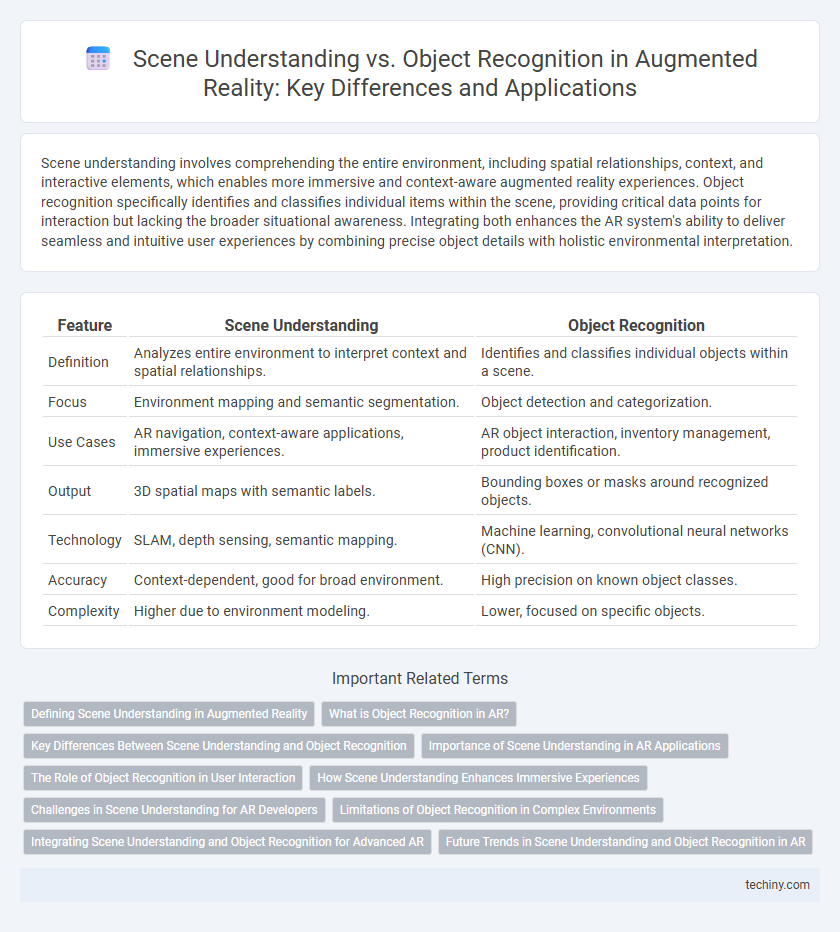Scene understanding involves comprehending the entire environment, including spatial relationships, context, and interactive elements, which enables more immersive and context-aware augmented reality experiences. Object recognition specifically identifies and classifies individual items within the scene, providing critical data points for interaction but lacking the broader situational awareness. Integrating both enhances the AR system's ability to deliver seamless and intuitive user experiences by combining precise object details with holistic environmental interpretation.
Table of Comparison
| Feature | Scene Understanding | Object Recognition |
|---|---|---|
| Definition | Analyzes entire environment to interpret context and spatial relationships. | Identifies and classifies individual objects within a scene. |
| Focus | Environment mapping and semantic segmentation. | Object detection and categorization. |
| Use Cases | AR navigation, context-aware applications, immersive experiences. | AR object interaction, inventory management, product identification. |
| Output | 3D spatial maps with semantic labels. | Bounding boxes or masks around recognized objects. |
| Technology | SLAM, depth sensing, semantic mapping. | Machine learning, convolutional neural networks (CNN). |
| Accuracy | Context-dependent, good for broad environment. | High precision on known object classes. |
| Complexity | Higher due to environment modeling. | Lower, focused on specific objects. |
Defining Scene Understanding in Augmented Reality
Scene understanding in augmented reality (AR) involves the comprehensive analysis of the environment to interpret spatial relationships, semantic context, and dynamic elements beyond merely identifying individual objects. This process integrates depth sensing, surface mapping, and environmental semantics to create a coherent digital representation that enables realistic interaction and occlusion handling. Unlike object recognition, which focuses on detecting and classifying isolated items, scene understanding enables AR systems to comprehend the entire environment for immersive and context-aware experiences.
What is Object Recognition in AR?
Object Recognition in Augmented Reality (AR) refers to the technology that identifies and classifies specific objects within a real-world environment using computer vision algorithms. It enables AR systems to precisely overlay digital content onto recognized objects, enhancing user interaction and contextual relevance. This capability is essential for applications like AR gaming, retail, and industrial maintenance, where accurate object identification drives immersive and functional experiences.
Key Differences Between Scene Understanding and Object Recognition
Scene understanding interprets spatial relationships and context within an environment, enabling devices to grasp the layout and interactions between multiple objects holistically. Object recognition identifies and classifies individual items within a scene based on specific features, concentrating on detecting distinct objects without comprehending their surrounding context. Key differences include scene understanding's emphasis on spatial semantics and environment comprehension, whereas object recognition focuses on feature extraction and object categorization.
Importance of Scene Understanding in AR Applications
Scene understanding in augmented reality (AR) applications enables the system to interpret spatial relationships, environmental context, and dynamic elements, providing a comprehensive framework for realistic interaction. Unlike object recognition, which identifies individual items, scene understanding integrates these objects into a cohesive model, improving the accuracy of virtual content placement and user engagement. This holistic perception is crucial for advanced AR experiences such as navigation, gaming, and industrial maintenance, where context-aware responses enhance usability and immersion.
The Role of Object Recognition in User Interaction
Object recognition plays a crucial role in user interaction within augmented reality by enabling the system to identify and track specific items in the environment, facilitating precise and context-aware digital overlays. Unlike broader scene understanding, object recognition allows AR applications to respond dynamically to individual objects, enhancing user engagement through interactive elements such as manipulation, annotation, or real-time feedback. This targeted recognition improves the accuracy of AR experiences, making interfaces more intuitive and responsive to user actions.
How Scene Understanding Enhances Immersive Experiences
Scene understanding processes spatial relationships, depth, and environmental context, enabling augmented reality systems to integrate virtual elements seamlessly within physical spaces. This comprehensive analysis surpasses object recognition's focus on identifying isolated items by interpreting entire surroundings, resulting in more realistic and interactive AR experiences. Enhanced scene understanding supports dynamic occlusion, lighting adaptation, and gesture interaction, deepening user immersion and engagement.
Challenges in Scene Understanding for AR Developers
Scene understanding in augmented reality involves interpreting complex environments with diverse objects, dynamic lighting, and varying spatial relationships, posing significant challenges for AR developers. Unlike object recognition, which focuses on identifying individual items, scene understanding requires comprehensive analysis of context, depth, and semantic meaning to create immersive experiences. Overcoming issues such as real-time processing constraints, occlusions, and environmental variability is critical for accurate and responsive AR applications.
Limitations of Object Recognition in Complex Environments
Object recognition in augmented reality often struggles with occlusions, lighting variations, and background clutter, reducing accuracy in complex environments. Scene understanding addresses these limitations by analyzing spatial relationships and contextual information, enabling more robust interaction and navigation. Consequently, scene understanding enhances AR applications by providing a holistic interpretation beyond isolated object identification.
Integrating Scene Understanding and Object Recognition for Advanced AR
Integrating scene understanding and object recognition in augmented reality enhances spatial awareness by combining environmental context with precise identification of individual objects. This fusion enables AR systems to deliver more immersive and interactive experiences, such as real-time object manipulation within accurately mapped surroundings. Advanced algorithms leveraging deep learning and computer vision facilitate seamless integration, improving accuracy and responsiveness in complex, dynamic environments.
Future Trends in Scene Understanding and Object Recognition in AR
Future trends in Augmented Reality emphasize enhanced scene understanding through advanced AI models that enable real-time semantic segmentation and 3D environment mapping, facilitating more immersive and context-aware user experiences. Progress in object recognition involves leveraging deep learning and edge computing to achieve higher accuracy and faster identification of diverse objects in dynamic environments, improving AR applications in retail, healthcare, and industrial maintenance. Integration of multimodal sensors and continuous learning algorithms is expected to blur the lines between scene understanding and object recognition, driving the next generation of intelligent AR systems.
Scene Understanding vs Object Recognition Infographic

 techiny.com
techiny.com